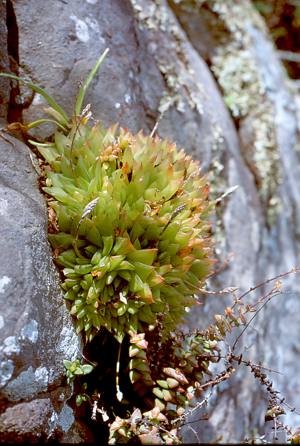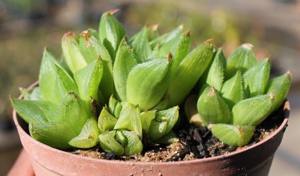Haworthia cymbiformis
Haworthia cymbiformis (Haw.) Duval var. cymbiformis
Family: Asphodelaceae
Common names: cathedral window haworthia
Introduction
This is a succulent plant with a restricted distribution in southern Africa . The succulent leaves of this relatively small plant allow it to withstand the harsh, scorching conditions in some parts of the region. It is mainly found on rocky surfaces.

Description
Description
Harworthia cymbiformis is a succulent, ground covering plant which is relatively small in size, with clusters reaching a height of 150 mm. Haworthia cymbiformis has rosettes of evergreen leaves. The leaves are succulent and often light green in colour. The leaves further have the striking characteristic that their tips are translucent. The whitish flowers are long and tubular with thin stems. Flowering time is from mid spring or early summer. These plants are able to grow relatively fast, with the growth rate greatly influenced by factors such as water availability, supplementary feeding and suitability of the environment.

Conservation Status
Status
This plant is currently Red Listed as Least Concern (LC) and is not endangered.
Distribution and habitat
Distribution description
Harworthia cymbiformis is widespread between Port Elizabeth, the Mbhashe River and inland to Cathcart. This plant cannot survive frost or low winter temperatures, however it can survive short droughts as well as high temperatures.
Derivation of name and historical aspects
History
More than 70 southern African species of succulent plants are included in the genus Haworthia. The genus was named after Adrian H. Haworth (1768-1833), an English botanist.
Ecology
Ecology
These plants have adapted to grow in soils with a pH of between 6.1 and 7.6. Haworthia cymbiformis seeds are dispersed by wind.
Uses
Use
There are no known cultural or medicinal uses known for Haworthia cymbiformis.

Growing Haworthia cymbiformis
Grow
These plants are easy to grow in summer rainfall areas, without too much water.
Haworthia cymbiformis prefers a sunny to half-shady environment. It grows best in sandy-gritty soil that is dry or moderately moist. The growing season of these plants is usually during the summer rainfall months. If the plants are watered during the wrong time of the year, they may be killed. Occasional watering is required accompanied with systemic insecticides. This will keep the plant free of mealy bug, which is the plant's main pest. Plants are propagated by dividing rhizomes. It can also be propagated from leaf cuttings: allow the cut surface to callous over before planting. To propagate plants from seed, sow directly after the season's last frost.
References
- Pienaar, K. 1987. The A-Z of garden flowers in South Africa . Struik Publishers, Cape Town.
- Pooley, E. 1998. A field guide to wild flowers KwaZulu-Natal and the Eastern region. Natal Flora Publication Trust, Durban.
- Pooley, E. 2003. Mountain flowers, a field guide to the flora of the Drakensberg and Lesotho. The Flora Publication Trust, Durban.
Credits
Sthembile Zondi
KwaZulu-Natal National Botanical Garden
August 2013
Plant Attributes:
Plant Type: Ground Cover, Succulent
SA Distribution: Eastern Cape
Soil type: Sandy
Flowering season: Spring, Early Summer
PH: Acid, Alkaline, Neutral
Flower colour: White
Aspect: Full Sun, Morning Sun (Semi Shade), Afternoon Sun (Semi Shade)
Gardening skill: Easy
Special Features:
Horticultural zones









Rate this article
Article well written and informative
Rate this plant
Is this an interesting plant?
Login to add your Comment
Back to topNot registered yet? Click here to register.